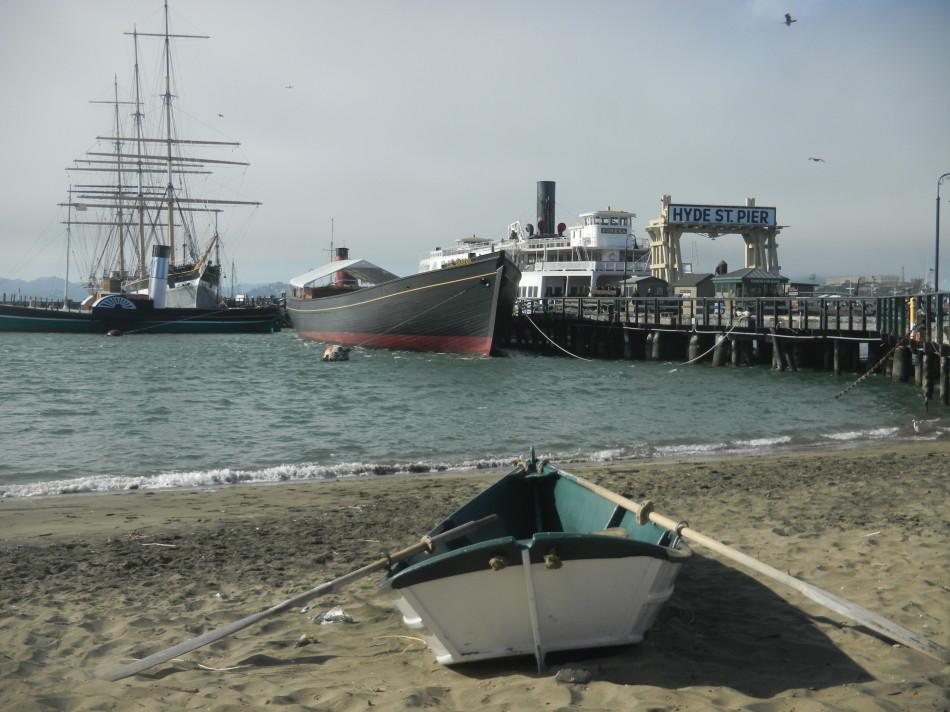Sail away into California history
Depart from Hyde St. Pier into history via one of the several famous ships that the San Francisco Maritime National Historical Park preserve. Photo credit: Lea Naqishbendi
Visit San Francisco Maritime National Historical Park at:
900 Beach St.
San Francisco, CA, 94109
(415) 447-5000
10 a.m. – 4 p.m. daily
Cost: $5 and under
Discover the lives of early native locals at either of the San Francisco Maritime National Historical Park sites. Located in the Russian Hill neighborhood and Fisherman’s Wharf, experience the life of the early Californian maritime at the Visitor Center on Beach Street or via historic ships from Hyde Street Pier.
As you enter the park’s Visitor Center, you are greeted by a California ranger who is very informative and helpful. The museum exposes you to eras from the Ohlone to the modern. Displays are real physical artifacts from the various time periods in the Bay Area.
Life-like murals cover several walls, depicting the different eras of the Ohlone boat builders and displaying their canoes made of woven tule reeds caught from marshes. The Ohlones also built larger boats that were used for hunting, fishing, and transporting goods along the shore and across the Bay. The reeds were a sufficient boat making material, each tule stem filled with hundreds of tiny air pockets, making it both lightweight and buoyant.
The museum has multiple illustrations detailing the life of other native Bay Area local populations. On another mural, the Yelamu, another local native population, are displayed feasting on their daily catch of fish and roasting them over open fire. The art is so real that it enables one to travel back in time to when the Yelamu occupied the land.
In a glass enclosed area, numerous artifacts and skeletons of the Gold Rush Era are displayed its original place of deposition. Adjacent to it, there is a bench with a large video screen that illustrates the entire history of the Bay Area and the tremendous role it played locally, nationally, and internationally in trade.
The San Carlos was the first ship to sail into the Bay Area in 1775 from Europe. Six years earlier, a Spanish land expedition had sited the Bay, and the San Carlos and its crew was first to chart its waters.
Captain Ayala noted that the Bay offered easy access into the interior and was vital to the Spanish control of the West Coast. Some of the ships that followed the San Carlos’ arrival can be found across the street from the visitor center. As you exit the museum, you are met by the Farallon Island Lighthouse, and also a scrimshawed whale’s tooth.
Once across the street, you come to the second part of the museum where majestic tall ships are displayed, as well as several large machines that were used for important ship activities. Among them stand a completely restored steamship engine and a gigantic steamship wheel that belonged to the Petaluma.
Also exhibited is a large machine that was used to pull the ships into the wharf. On the right side, they have several smaller buildings that allow visitors to come in and experience first hand the precise, intricate, and artistic process that it takes to build a ship.
Right next door is the restored tug boat, Hercules, as well as several others from as early as the 18th century that you are allowed to board and depart in. Among them are the square-rigged ship Balclutha, a San Francisco built scow shooner Alma, C.A. Thayer, Eppleton Hall, and finally the side-wheel ferry Eureka.
On the other side, you have a well maintained multistory building that houses a wide-range of Maritime artifacts, as well as replicas of the original ships that played a pivotal role trading in both California and abroad..
The museum offers rewards that are priceless; you can enter the Visitor Center for free and it’s only $5 for the fleet of vessels. The Museum provides visitors and volunteers the opportunity to dwell upon the changes over the centuries that made San Francisco what it is today, and at just a few miles away from Skylines backyard.







